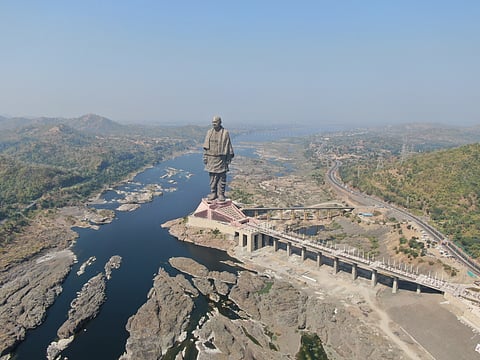
- Destinations
- Experiences
- Stay
- What's new
- Celebrating People
- Responsible Tourism
- CampaignsCampaigns
- Subscribe
- Buy Now

Sardar Vallabhbhai Patel played a crucial role in uniting over 565 princely states into independent India. As a freedom fighter, India’s first Deputy Prime Minister, and Home Minister, he strengthened the Indian Administrative Service and the Congress organisation. Key landmarks associated with him include the Sardar Vallabhbhai Patel National Memorial in Ahmedabad, the Bardoli Satyagraha site, and his birthplace memorial in Karamsad. With his birthday approaching on October 31, you may also consider visiting the Statue of Unity in Kevadia, Gujarat. Here's what to know about it.
The Statue of Unity, standing at 597 feet, is said to be the tallest statue in the world, surpassing China’s Spring Temple Buddha at 503 feet. Other notable tall statues include Myanmar’s Laykyun Setkyar Buddha at 427 feet and Japan’s Ushiku Daibutsu at 394 feet.
The statue was inaugurated on 31 October 2018 to mark the 143rd birth anniversary of India’s first Home Minister, Sardar Vallabhbhai Patel. Built at a cost of 2,389 crore rupees, it comprises 70,000 tonnes of cement, 18,500 tonnes of reinforcement steel, 6,000 tonnes of structural steel, and 1,700 metric tonnes of bronze. The statue is surrounded by a 12 square kilometre artificial lake.
The Sardar Vallabhbhai Patel Rashtriya Ekta Trust (SVPRET) was set up as a special purpose vehicle to oversee the construction of the Statue of Unity. Under the "Loha" campaign, the trust collected around 129 tonnes of iron implements from nearly 100 million farmers across 169,000 villages in all Indian states. This iron formed the base of the statue.
The surrounding complex offers much more than the monument itself. It features an informative museum, a spacious exhibition hall, and a dedicated research centre. Together, these facilities provide visitors with a detailed insight into Sardar Patel’s life, his political journey, and his pivotal role in shaping independent India’s nation-building efforts.
Situated on the river island of Sadhu Bet near Rajpipla in Gujarat, the Statue of Unity provides breathtaking panoramic views of the Narmada river, the dam, and the Satpura and Vindhyachal ranges. Visitors can access the viewing chamber at 442.9 feet through two passenger elevators, which can accommodate up to 200 people at a time. The viewing gallery, positioned at 153 meters, offers a stunning perspective of the surrounding landscape.
The best time to visit the Statue of Unity is between October and March when the weather is pleasant. Comfortable clothing and walking shoes are essential, and visitors should consider bringing a sun hat, sunglasses, or weather-appropriate outerwear, particularly during the hotter months. Staying hydrated is also recommended during summer.
Visitors can choose from a variety of ticket options depending on the experiences they wish to enjoy. General entry provides access to the monument, museum, and surrounding areas. Express entry allows skip-the-line access to the observation deck. Viewing gallery tickets include access to the observation deck, the museum, and a 3D movie. Full-day packages offer access to multiple attractions, including activities such as the Jungle Safari, Laser Light and Sound Show, and river experiences. A typical visit lasts between one and three hours, giving ample time to explore both the statue and the surrounding complex.
The Statue of Unity has faced significant criticism for its environmental impact, making it important to examine its effects on local ecology and communities. Construction involved clearing farmlands and natural habitats, while land of cultural and spiritual importance to local Adivasi communities was acquired, raising concerns about displacement and potential submergence of villages. Some associated works, such as the Garudeshwar weir, reportedly proceeded without proper public consultation or environmental clearance, raising questions about regulatory compliance.
Located near the Sardar Sarovar Dam and just 3.2 kilometres from the Shoolpaneshwar Sanctuary, the statue has raised concerns over downstream ecological disruption, including impacts on fishing, flood risks, and wildlife habitats. While the environmental movement as we know it did not exist during Sardar Patel’s time, his practical, Gandhian-inspired focus on public welfare, cleanliness, and self-reliance laid the groundwork for modern environmental values. Maintaining such a massive structure remains an ongoing ecological challenge.
Getting There
The Statue of Unity in Kevadiya is accessible by road from Vadodara, Surat, and Ahmedabad. Private vehicles must be parked at the designated lot, from where shuttle buses transport visitors to the monument.
Entry
Tickets can be booked online for two-hour slots at soutickets.in. The statue is open from 9 am to 5 pm every day except Mondays. Entry costs INR 350 for adults and INR 200 for children, with an additional INR 30 for the bus service.
Tips
For first-time visitors, it’s best to arrive early to avoid crowds and enjoy the full experience, including the museum, exhibition hall, and observation deck. Comfortable footwear, sun protection, and a water bottle are recommended, especially during warmer months. A typical visit takes around 2–3 hours.
Who does the Statue of Unity honour?
It commemorates Sardar Vallabhbhai Patel, the “Iron Man of India,” who unified over 565 princely states into independent India.
Where is it located?
On Sadhu Bet island near Rajpipla, Gujarat, overlooking the Narmada River and surrounded by a 12 sq km artificial lake.
Are there environmental concerns?
Yes, including cleared farmlands, tribal displacement, flood risks, and impact on nearby Shoolpaneshwar Wildlife Sanctuary.
What long-term environmental impacts are expected from the Statue of Unity?
Experts note that the statue’s massive bronze structure will naturally oxidise over time, turning green due to pollution and acid rain. Ongoing maintenance of the monument also poses environmental challenges, keeping its ecological footprint under discussion.
